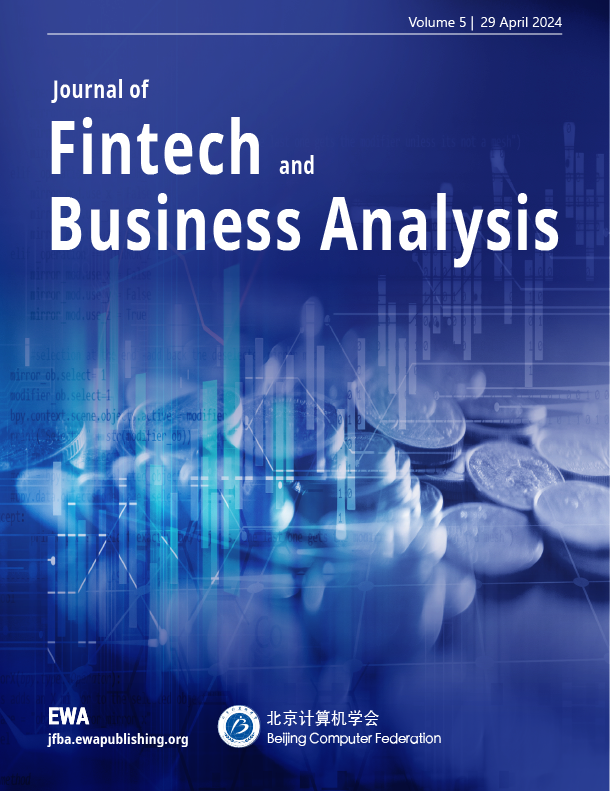

About JFBAJournal of Fintech and Business Analysis is an open-access international academic journal hosted by Beijing Computer Federation, and published by EWA Publishing. It primarily publishes articles related to digital economy, digital finance, and business analytics. The aim of JFBA is to focus on the development trends in digital economy and digital finance, gathering academic insights in research areas such as digital economy and society, data analytics and intelligent business, digital finance technology research, and digital financial tools application. Additionally, it covers fields such as computer technology and business model innovation, data analysis and supply chain optimization, and big data and risk control warning in the business analytics domain. JFBA provides valuable academic outcomes to scholars, professionals, and readers in these related fields to promote academic exchange.For more details of the JFBA scope, please refer to the Aim & Scope page. For more information about the journal, please refer to the FAQ page or contact info@ewapublishing.org. |
| Aims & scope of JFBA are: ·Digital Economy ·Fintech ·Business Analysis and Management |
Article processing charge
A one-time Article Processing Charge (APC) of 450 USD (US Dollars) applies to papers accepted after peer review. excluding taxes.
Open access policy
This is an open access journal which means that all content is freely available without charge to the user or his/her institution. (CC BY 4.0 license).
Your rights
These licenses afford authors copyright while enabling the public to reuse and adapt the content.
Peer-review process
Our blind and multi-reviewer process ensures that all articles are rigorously evaluated based on their intellectual merit and contribution to the field.
Editors View full editorial board

London, United Kingdom
canh.dang@kcl.ac.uk

Beijing, China

London, United Kingdom
an.nguyen@kcl.ac.uk

Birmingham, United Kingdom
Chinny.Nzekwe-Excel@bcu.ac.uk
Latest articles View all articles
E-commerce platforms have been experiencing exponential growth and expanding worldwide, with the most significant growth observed in Asia. This paper delves into the landscape of e-commerce platforms in China, meticulously dissecting their diverse business models and prevailing trends. Simultaneously, it explores the mutually beneficial relationship between e-commerce, express logistics, and online payment systems. This study analyzes these effects using data from government sources and news reports, including regional GDP, online retail sales, and regional logistics volume. The findings indicate that e-commerce platforms have had an overall positive impact on China's economy by fostering business innovation, reducing the urban-rural gap, and driving economic prosperity.

 View pdf
View pdf


With the development of the internet, live e-commerce has emerged, where different influencers and product types correspond to varying marketing results. This paper focuses on the live e-commerce industry, reviewing the related research of domestic and international scholars such as Zhao Hongmei and Han Haoliang. It analyzes and predicts the types of influencers and various products, presenting the basic situation and statistical data of the online live streaming marketing market, and forecasting the future market scale. In addition, the paper takes Li Jiaqi and Dongfang Zhenxuan as examples to analyze the characteristics of similar influencers and the factors influencing their impact. A series of conclusions are drawn, which are of significant practical importance for understanding the development trends of live e-commerce.

 View pdf
View pdf


Insertion-style advertisements have become one of the most prevalent methods for enhancing brand awareness in contemporary marketing. These advertisements take on a variety of forms and are strategically placed within media content. This study investigates the impact of the placement of insertion-style advertisements in film and television productions on consumers' purchase intentions. The research primarily employs an experimental grouping method, conducting online questionnaire surveys among 200 Chinese internet users across different regions via relevant platforms. Based on the analysis of the questionnaire results, it is evident that inserted advertisements placed in the middle section of films or TV shows yield the best overall user behavioral performance. Advertisements positioned at the end of the content tend to have a lower completion rate, while those at the beginning exhibit some limitations in engagement. Brands can enhance brand exposure and recognition by strategically placing a significant number of advertisements in the middle sections of films or TV shows, which positively influences consumers' purchase intentions.

 View pdf
View pdf


As a leading brand of tea drink chain in China, in recent years, MIXUE Ice Cream Tea (MIXUE Bingcheng) has completed its industrial layout by rapidly expanding its stores by virtue of its advantages in the market. In the process of brand operation also based on price, supply chain management, franchise mode, and brand IP quickly become one of the important brands in China's milk tea beverage industry. Therefore, this paper analyzes MIXUE Ice Cream and Tea's strategic decisions (including price, supply chain, franchise model, and IP management) to find out the unique business model of MIXUE Ice Cream and tea and discusses the key factors that make it stand out in the fierce market competition. The analysis shows that MIXUE Ice Cream & Tea 's low price and efficient supply chain play an important role in its rapid expansion and market share growth, while effectively reducing operational risks and costs.

 View pdf
View pdf


Volumes View all volumes
2024
Volume 1October 2024
Find articlesAnnouncements View all announcements
Journal of Fintech and Business Analysis
We pledge to our journal community:
We're committed: we put diversity and inclusion at the heart of our activities...
Journal of Fintech and Business Analysis
The statements, opinions and data contained in the journal Journal of Fintech and Business Analysis (JFBA) are solely those of the individual authors and contributors...
Indexing
The published articles will be submitted to following databases below:





